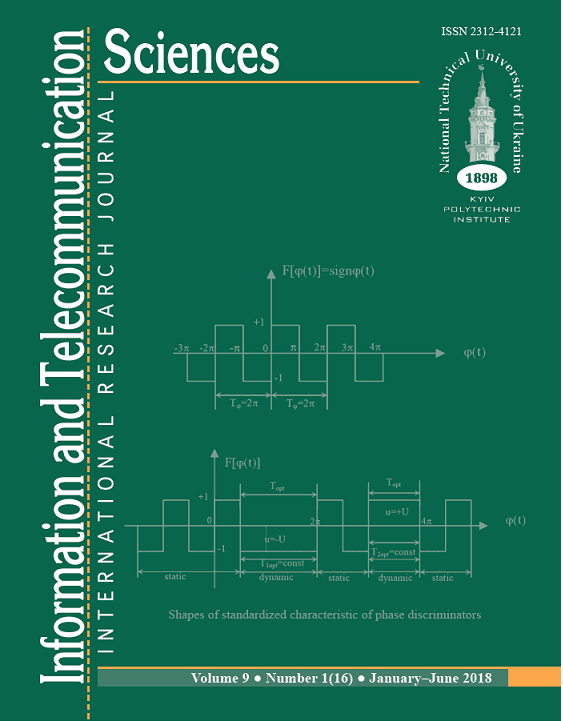COMPUTATION OF PROVIDING SERVICES INTEGRAL QUALITY INDEX
DOI:
https://doi.org/10.20535/2411-2976.12018.34-42Keywords:
Big Data, fuzzy knowledge base, fuzzy logic, service quality, integral quality index.Abstract
Background. The paper is devoted to review and improvement of existing algorithms for assessing the service provision quality by a telecom operator. Modern approaches to determining the level of service quality in the operator's telecom system require the use of complex mathematical methods and approaches that have significant computational complexity. The proposed
approach to assessment of the provided services quality is based on a generalized quality function defined as the geometric average of the individual quality indicators of the operator's telecom monitoring system and allows the formation of fuzzy knowledge base in the form of the structured rules. To obtain the value of the integral indicator the rules of the fuzzy knowledge base are trained using the desirability function and the clustering method. The data set presentation to obtain from the operator's telecom monitoring system at certain time intervals in the form of the fuzzy knowledge base structured rules allows to reduce the making decision time on the service provision quality significantly, as well as to reduce the computational complexity of the service provision quality determining.
Objective. Improving the service provision quality to the end user through "soft" condition control of the operator's system performance indicators and reducing computational complexity in determining their quality.
Methods. The study was carried out based on a large number of literary sources analysis, the theory of fuzzy logic, clustering methods with using the generalized quality function, the theory of fuzzy knowledge base.
Results. An approach is proposed to determining the integral quality indicator of the provided by the telecom operator to the end user services, obtaining the complex non-structured data estimation based on one integral fuzzy indicator and forming on its basis a knowledge system represented as the fuzzy knowledge base. When forming a fuzzy knowledge base, it takes time to learn
its rules, but this is compensated by computational load reduction on the system during its operation.
Conclusions. The presented research indicates the need to improve the modern telecom operator’s platform for the services provision that realized by an additional block of "soft" services quality management with the help of fuzzy knowledge base. This modification allows instead of processing Big Data from the telecom operator's monitoring system to determine the quality of services based on the rules of the fuzzy knowledge base.
Keywords: Big Data; fuzzy knowledge base; fuzzy logic; service quality; integral quality index.
References
Y.Y. Bolyubash, “Methods and tools for processing large data resources in information systems of territorial administration”, Ph.D. dissertation, software for computer systems, Lviv Polytechnic, Lviv, Ukraine, 2017.
M. Ulema. “Big Data and Telecommunications Telecom Analytics” – Tutorial II, BlackSeaCom’2016.
S. Russell, P. Norvig, “Artificial Intelligence: A modern approach”, New Jersey, Upper Saddle River, 2010.
M. Tim Jones, “Artificial Intelligence: A Systems Approach”, Hingham, Massachusetts, New Delhi, Infinity Sci. press LLC, 2008.
D. Kriesel, “A Brief Introduction to Neural Networks”, http://www.dkriesel.com/en/science/neural_networks.
J. A. Cruz, Wishart D. S. Cancer Informatics, 2006 - 2:59–77.
C. Szepesv`ari, “Algorithms for Reinforcement Learning”, Synthesis Lectures on Artificial Intelligence and Machine. Learning series by Morgan & Claypool Publishers, 2009.
X. Zhu, “Semi-Supervised Learning Literature Survey”, Tech. Rep. 1530. University of Wisconsin-Madison, 2008.
T. Kohonen, Biological Cybernetics - 1982 - 43(1):59–69.
A.K. Jain, M. N. Murty, P. J. Flynn, “ACM Computing Surveys”, - 1999 - 31(3):264–323.
W.A. Barbakh, Y. Wu, C. Fyfe, “Studies in Computational Intelligence”, - 2009 - 249:7–28.
T.O. Ayodele, “Types of Machine Learning Algorithms”, New Advances in Machine Learning. INTECH Open Access Pub., - 2010 - pp. 19–48.
H.A.H. Ibrahim, S.M. Nor, A. Mohammed, A.B. Mohammed, International Journal of Computer Networks and Wireless Communications, - 2012 - 2(1):69–73.
R.I. Mukhamediev, E.L. Mukhamedieva, Ya.I. Kuchin, «Taxonomy of machine learning methods and quality assessment of classification and learning », Electronic Journal “Cloud of Science”, T. 2, № 3, 2015
A.D. Mauro, M. Greco, M. Grimaldi, “What is Big Data? A Consensual Definition and a Review of Key Research Topics”, 4th International Conference on Integrated Information, AIP Proceedings, 2014.
B. Marr, J. Wiley, “Big Data: Using SMART Big Data, Analytics and Metrics To Make Better Decisions and Improve Performance”, Sons Ltd, 2015.
J. Espinosa, J. Vandewalle, V. Wertz, “Fuzzy logic, identification and predictive control”, — London: Springer-Verlag, 2005. — 263 p.
Y.А. Zak, “Alternative defuzzification Algorithms”, System Research and Information Technologies. — 2015. — № 1. — pp.111-120. — Ref.: 6 titles — рос.
Downloads
Published
How to Cite
Issue
Section
License
The ownership of copyright remains with the Authors.
Authors may use their own material in other publications provided that the Journal is acknowledged as the original place of publication and National Technical University of Ukraine “Igor Sikorsky Kyiv Polytechnic Institute” as the Publisher.
ITS articles are published under Creative Commons licence:
- Authors retain copyright and grant the journal right of first publication with the work simultaneously licensed under CC BY 4.0that allows others to share the work with an acknowledgement of the work's authorship and initial publication in this journal.
- Authors are able to enter into separate, additional contractual arrangements for the non-exclusive distribution of the journal's published version of the work (e.g., post it to an institutional repository or publish it in a book), with an acknowledgement of its initial publication in this journal.
- Authors are permitted and encouraged to post their work online (e.g., in institutional repositories or on their website) prior to and during the submission process, as it can lead to productive exchanges, as well as earlier and greater citation of published work.

